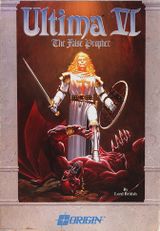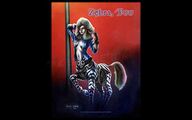Ultima VI: The False Prophet
Ultima VI: The False Prophet is the sixth game in the series and the last part of the "Age of Enlightenment" trilogy. It was published and released in 1990 by Origin for the IBM PC. Ports for the Atari ST and C64 followed in 1991. A port for the Amiga was released in 1992. Ports for the FM Towns in 1992 and SNES in 1993 were next.
Gameplay[edit]
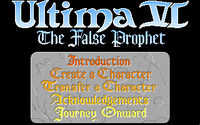
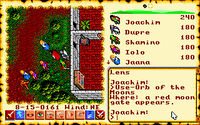
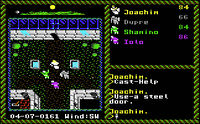
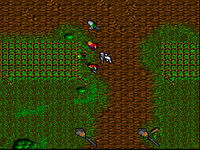
Ultima VI features major changes to the graphics and gameplay compared to previous games. Gone are the notorious tiled graphics, different scales, and 3D-dungeons from all previous Ultimas. Everything is now shown from a isometric perspective with attention to detail in a seamless world, making Britannia look much more realistic. Though the graphics are tile based, the tiles are integrated in a way that does not make them so independent to each other, but only as parts of the bigger world. Castles, towns and dungeons are in the same scale as the overworld, unlike previous Ultimas, where entering any of these places would move the player to a separate, different scale map.
Every character now has a portrait when spoken to, the inventory is now graphical, the game is mouse driven, and the characters and story have become more complex and mature than they were in Ultima V. Music support is available for the first time in the PC version.
Like in the previous game, a character transfer is possible on most versions of the game. The exception to this are the ports for the C64 and FM Towns.
The Story[edit]
Spoiler warning: Plot and/or ending details follow.
After the rescue of Lord British and the mostly-complete collapse of the Underworld, Britannia seems to have found peace again, but it does not last for long. From what remains of the Underworld, strange creatures called gargoyles arise, starting a war against the humans of Britannia. The war has lasted for some years and the gargoyles have captured the Shrines by stealing the moonstones.
In this situation, the Avatar is lured to Britannia by a red moongate and nearly sacrificed by the gargoyles. Freed at the last moment, the hero begins a campaign to reconquer Brtiannia by freeing the shrines and moonstones from the gargoyles. But a strange book from the sacrifice scene and a mysterious translation silver tablet reveal a horrible secret: the gargoyles are not the basically evil monsters they appear to be, but are a desperate people trying to save themselves from destruction. They think the Avatar is their legendary "False Prophet," come to destroy them, as their homeland slowly collapses more with each day. Traveling to the Realm of the Gargoyles on a peaceful mission, the hero realizes that the Codex of Ultimate Wisdom is both the biggest point of bitterness between the two races and the only voice of reason to which they will listen.
The Avatar sends the Codex back into the Void, where no one can claim it, but leaving two special lenses with which both Kings can view it, to continue to read its wisdom and learn the truth. And so, peace is again restored to the troubled land.
Spoilers end here.
Development[edit]
This is the first time an Ultima was developed on a 16-bit computer (namely the IBM PC) and not the Apple II.
For the creation credits, see: Credits (Ultima VI)
Differences between platforms[edit]
16-bit computers[edit]
- Main article: Computer ports of Ultima VI
The 16-bit Atari ST and Amiga ports of Ultima VI are similar to the PC version, but are limited to far fewer colors (16 and 32, respectively) and less music (with some differences in composition for pieces that remain). Regardless, they occupy a larger number of floppy disks.
In Japan, 16-color ports for the PC-98 and X68000 systems were produced, as well as a 256-color release for the FM Towns. While largely identical to the original PC version, the FM Towns-port is unique among all editions of Ultima VI in featuring fully recorded speech, both Japanese and English, for all characters; in the latter language, characters with real-world counterparts are often voiced by the person on whom they are based (for example, Lord British and Shamino are played by Richard Garriott). The conversation system itself also differs: keywords are not typed by the player but selected from a list, and must first be learned through dialogue before they will appear. The FM Towns version included a full-color poster not found with other releases of the game.
Commodore 64[edit]
- Main article: C64-port of Ultima VI
Marking the final appearance of a mainline Ultima on 8-bit platforms, the only such port of Ultima VI is for the Commodore 64. Origin was able to fit the game, albeit with some changes, onto three double-sided disks. Alterations to accommodate the system include a significant reduction in visual detail, dialogue complexity, and world interactivity (functional items, containers, etc.), while character portraits, sound effects and most music (introduction and ending sequences excepted) were removed altogether. With the in-game rationale that they were eaten by gargoyles, horses (and therefore horse riding) are also absent with the notable exception of Smith, who instead appears disguised as a cow. Furthermore, magic spells are approximately one-third fewer in number.
The game is controlled via keyboard and joystick on the Commodore 64, as computer mice, although available for the system, were not commonly used.
Super Nintendo[edit]
- Main article: SNES-port of Ultima VI
Ultima VI for the Super Nintendo is visually much like the PC version, but is full-screen and lacks character portraits. Restricted by the console's gamepad, this port utilizes a more convoluted system of menus and screen-switching, as well as a conversation system much like the FM Towns edition, whereby keywords must be learned then chosen from a list. Some elements of the original game have also been censored as per Nintendo's content policies at the time.
Soundtrack[edit]
Composition duties for Ultima VI initially fell to programmer and writer Herman Miller, who commenced work on the soundtrack after Thanksgiving in 1989. At the eleventh hour, however, his work was largely supplanted by a range of pieces written throughout the 1970s and 1980s by colleague Todd Porter, nephew of country guitarist Chet Atkins.[1] Porter's work is heard throughout the various introduction and character creation sequences, as well as the in-game wandering and dungeon themes.
Miller's only contributions to remain in the final release are his arrangement of the anthemic "Rule Britannia," as well as the composition of its derivative Gargish counterpart, "Audchar Gargl Zenmur." This would also mark the final credit for series mainstay Ken Arnold, who had a select few of his themes from Ultima V reprised in The False Prophet – notably including "The Ultima Theme" – while being credited for another two such pieces – "Halls of Doom" and "Worlds Below" – that do not appear in the game. Rounding out the collaborative soundtrack is the return appearance of David Watson and Kathleen Jones' wistful ballad, "Stones."[2]
Ultima VI brought with it a significant technical evolution in music for the series. Prior to the sixth chapter, support for music had been limited to hardware such as the Apple II series' Mockingboard and Commodore's SID chip. With the game developed natively on the PC, support came for a wider range of audio devices, including the AdLib Music Synthesizer Card, Creative Labs Sound Blaster, and notably the period's de facto industry standard, Roland MT-32. The latter module – with its combination of sample-based and subtractive synthesis – provided the highest fidelity audio performance yet heard in an Ultima and was used to record the Origin Soundtrack Series Volume 1 compilation album, which featured many tracks from the game. For a number of years thereafter, the MT-32 would continue to be the benchmark platform for Ultima music, as well as other Origin titles, until the eventual dominance of the CD-ROM medium brought with it the capacity to feature completely pre-recorded soundtracks.
Release[edit]
Ultima VI got very good reviews and sold quite well for Origin. It was voted best role-playing game by Computer Gaming Magazine in 1991.[3]
Ultima VI was also sold as a CD-bundle with Wing Commander, once from Software Toolworks and once from Origin themselves. It came together with the Compendium, but only a paper map of Britannia.
The game was later included in several compilations:
- Ultima Trilogy IV V VI (1992)
- Ultima I-VI Series (1993)
- Ultima Collection (1998)
In Japan, the game was included in the compilation Ultima Complete.
Distribution of the game in Europe was done by Mindscape.
Included with the game[edit]
The release of Ultima VI included these things with the game:
- The book Compendium
- A cloth map of Britannia in Ultima VI
- An Orb of the Moons (same as in the introduction)
- An insert about the Immortality Contest
- Only in some cases, a rune related to the Immortality Contest
- The Reference Guide
There was a "Special Limited Edition," which not only had a box signed by Richard Garriott and Denis Loubet, but also an audio tape.
Upgrades[edit]
Ultima VI is the first Ultima that does not need any kind of upgrades for sound or graphics to run in Windows XP. However, there are several projects in progress to allow it to run better on modern systems, or to remake it with other game engines.
The Ultima 6 Project[edit]
The Ultima 6 Project is a project to recreate Ultima VI with the Dungeon Siege game engine.
Nuvie[edit]
This is an open-source project designed to use the original data files for Ultima VI and make it playable on a number of different operating systems. See Nuvie for more information.
Ultima VI Online[edit]
Ultima VI Online is a multiplayer (MMORPG) version of Ultima VI. For more details, see Ultima VI Online.
Ultima VI auf Deutsch[edit]
Ultima VI auf Deutsch is a full translation of the game to German made by Sir John. Due to the way the game is programmed, a lot of the work had to be done by hex-editing the files and sometimes there had to be compromises. The project is complete and available.
Ultima VI Nitpickers Delight Patch[edit]
The Ultima VI Nitpickers Delight Patch created by Sir John edits conversations and books in the game in order to fix factual and continuity errors in them. The patch is complete and available.
Ultima VI: El Falso Profeta[edit]
Ultima VI: El Falso Profeta is a fan translation of the game into Spanish. The project is complete and available.
Ultima VI: Le Faux Prophète[edit]
Ultima VI: Le Faux Prophète is a fan translation of the game by Docwise Dragon into French. The project is complete and available.
Utilities[edit]
IT-HE Ultima 6 Editing Utilities[edit]
IT-HE Ultima 6 Editing Utilities are a suite of tools that allows a player to extensive modify Ultima VI.
Ultima VI Translation Tools[edit]
The Ultima VI Translation Tools developed by Sir John are an essential package that is needed when attempting to translate Ultima VI into a a language other than English.
More Game-Related Information[edit]
- For bugs in this game, see Ultima VI bugs.
- For cheating in this game, see Cheating in Ultima VI.
- For Easter eggs and real-life references in this game, see Ultima VI real-life references and Easter eggs.
- For a complete transcript of books, signs, and scrolls, see Ultima VI signs, scrolls, and books.
- For party members, see Party members in Ultima VI.
- For a complete walkthrough, see Ultima VI walkthrough.
- For details on map editing, see U6Edit.
- For monster data, see Ultima VI monster data.
- For a map viewer, see Ultimatrix.
- For technical details, see Ultima VI internal formats.
- For copy protection, see Ultima VI copy protection.
- For details on alcohol, see Alcohol in Ultima VI.
- For the locations of the various keys, see Key locations in Ultima VI.
- For how the character creation works, see Character creation
Trivia[edit]
- Ultima VI had various working titles in contention prior to the finalization of Denis Loubet's cover art, including Attack of the Blue Meanies, Beyond Britannia, The Evil One Returns, and The Book of Prophecy. The latter in particular was considered a serious candidate for the final subtitle before The False Prophet was ultimately decided upon.[4]
- When designing Ultima VI, Richard Garriott took inspiration from Origin titles Moebius, Knights of Legend, and particularly the icon-driven actions in Times of Lore, which led Garriott to implement a similar user interface in his own game.[5][6]
- This installment marks the first appearance of Armageddon, a uniquely devastating and plot-breaking spell that irreversibly vaporizes all living beings in the game save the Avatar and Lord British. With the potential for players attempting to reach the game's conclusion after using the spell, it was made impossible in the event of its casting to send the Codex of Ultimate Wisdom to the Ethereal Void.
- As with previous entries, players who finished Ultima VI could originally obtain a completion certificate by notifying Origin of their achievement. As well as Lord British's usual congratulatory text, this certificate carries a message in Gargish from Lord Draxinusom.
- A still of the Avatar watching television, from the introduction sequence of Ultima VI, briefly appears as a poster in the episode "Borowski und das Fest des Nordens" (originally aired 18 June, 2017) of long-running German police drama, Tatort.
- The picture of the female centaur seen in the introduction was not originally intended to be there. The team planned to have Patrick Nagel’s Woman in Jacket as the painting, but was unable to get the rights (the picture is partially seen in a screenshot on the backcover and fully seen on the back cover of the Softeware Toolworks edition of the Ultima I-VI Series). Thus artist Keith Berdak, who worked for Origin at the time, reused a drawing he published in the program for Soonercon 2 in 1986. The original linework – which ultimately was not used by the pixel artists – is seen in the gallery below.
Gallery[edit]
External Links[edit]
- The Ultima 6 Project
- Nuvie: The Ultima 6 Engine
- Ultima VI: The False Prophet on Notable Ultima
- Ultima VI: The False Prophet (Wikipedia)
- Ultima VI – The False Prophet on C64 Wiki
- Ultima VI nitpicks
- The Other Codex – Ultima VI
- Ultima VI on Ultima Aiera
- Ultima 6 Intro (YouTube)
References[edit]
- ↑ Addams, Shay. "Final Modifications". The Official Book of Ultima. COMPUTE Publications: 1992. Page 134.
- ↑ Malone, Greg. Compendium (Ultima VI). Origin Systems: 1990.
- ↑ Computer Gaming World, Number 83. June 1991. Page 48.
- ↑ Addams, Shay. "Finding a Name". The Official Book of Ultima (2nd ed.). COMPUTE Publications: 1992. Pages 132-133.
- ↑ Garriott, Richard. “Ultima VI Audio Cassette – Side B”. YouTube. 2012-11-13. Retrieved 2017-08-03.
- ↑ Addams, Shay. "Sweeping Changes". The Official Book of Ultima (2nd ed.). COMPUTE Publications: 1992. Pages 83-84.
